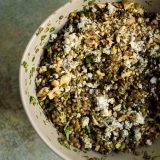David Lebovitz, full-time American in Paris, blogger and author of “My Paris Kitchen,” offers three tips for visitors: Never pay with large bills; always say bonjour and merci; bring your own food on planes.
He also has a soft spot for old, sometimes uncomfortable French eateries, such as Le Rubis. It’s the sort of place where charm overcomes a lack of culinary prescience.
Lebovitz recognizes that many French classics are not to be trifled with, and that includes the use of toothsome dark green lentilles du Puy. Whether served as a salad, a complement to seared duck breast, topped with lardons and tossed with goose fat, or simply cooked with stock with a splash of cognac, these are not just beans or, as they say in Europe, “pulses.” They stand on their own.
Lebovitz takes the classic approach. He simmers green lentils in a mirepoix of carrot, red onion and celery along with bay and thyme. At Milk Street, we can’t help but tinker a bit.
We prefer bigger flavors, and French cooking is based on a subtle melding of top-notch ingredients. A mirepoix of American supermarket vegetables does not compare to the ingredients available to Lebovitz.
Beginning with the same approach, we skipped the knife work, halving two carrots and a celery rib instead of dicing. We increased the bay and to build complexity in the cooking liquid. And in an ode to Dijon-spiked lentil salads, we added mustard seeds as well.
Next, rather than cooking the lentils straightaway, we let the vegetables and aromatics simmer before stirring in the lentils—essentially creating a quick vegetable broth. That meant the lentils would absorb flavor as they cooked. And when the lentils were tender (about 30 minutes later), we reserved the garlic—soft from its simmer—and some cooking liquid to build flavor in the dressing.
Before we made the broth, we stirred thinly sliced shallots into white balsamic vinegar to soften their bite; it also allowed the shallots to flavor the vinegar. We used this later, after the lentils had cooked. As they cooled, they absorbed the infused vinegar.
Our biggest hurdle was adding contrasting textures. We tried various additions—from radish, arugula and dried apricots to fennel, pistachios and pickled red cabbage—but ultimately settled on parsley and toasted chopped walnuts.
With the nuts’ crunch, bright fresh herbs, acidity from vinegar and the deep flavor in the lentils, the salad lacked only richness. We borrowed from the master of boldly flavored salads, Yotam Ottolenghi, and crumbled Gorgonzola over it, to serve the same function as lardons in an old-fashioned lentil recipe. It added much-needed fat and pungency.




